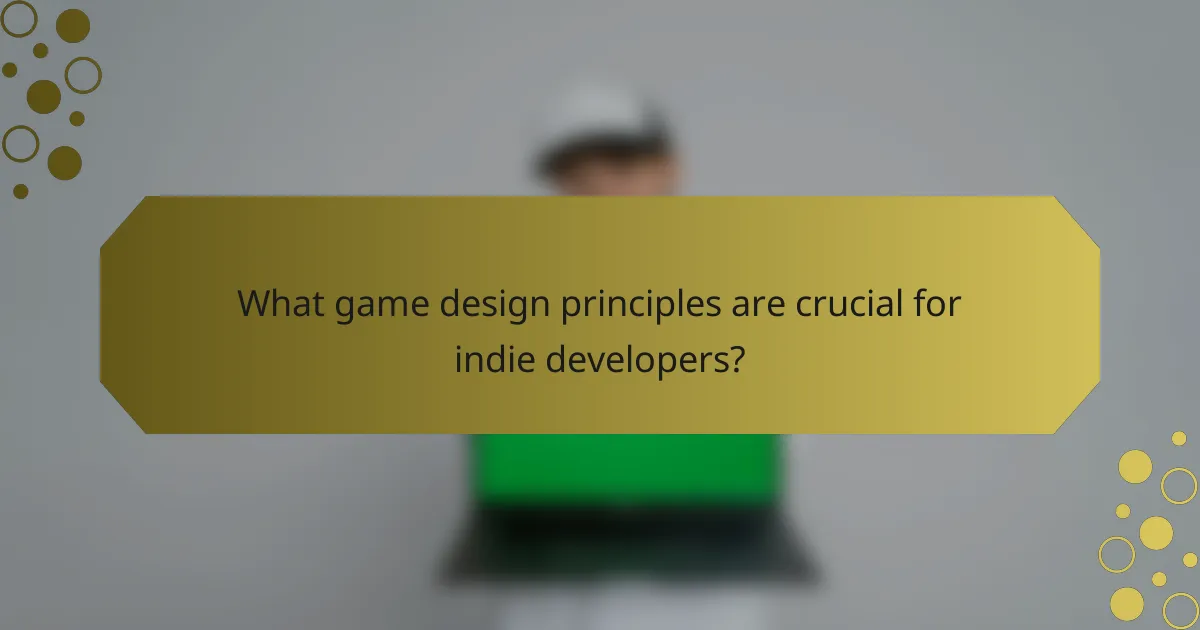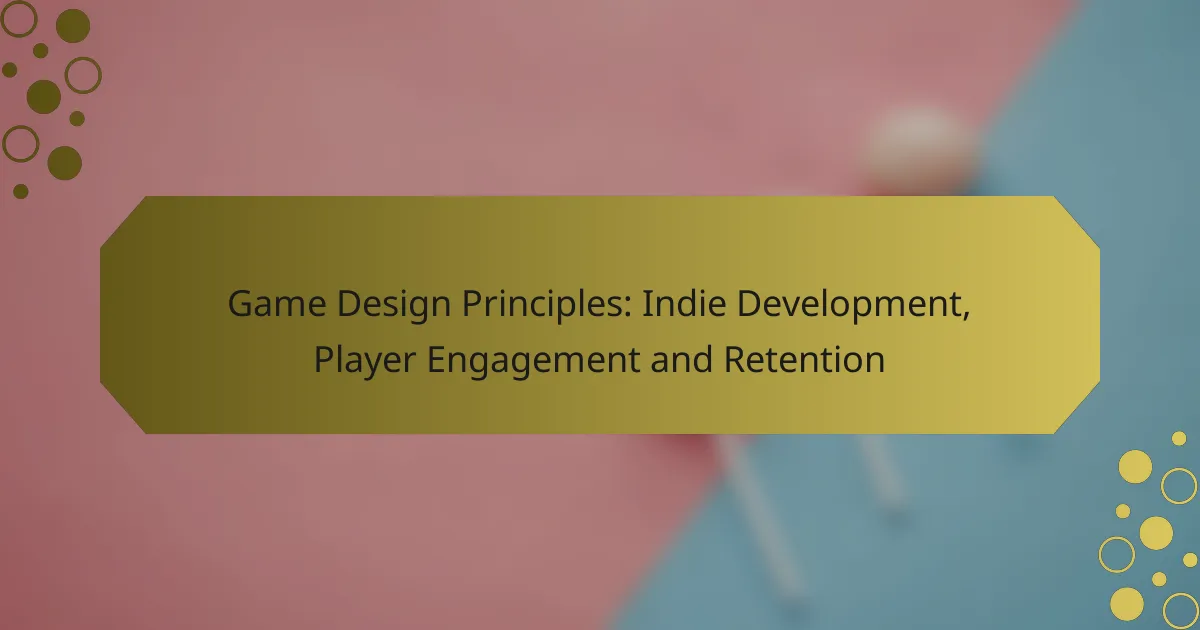In the realm of indie game development, creating engaging and immersive experiences is essential for capturing players’ attention and fostering long-term loyalty. By integrating unique storytelling, innovative gameplay mechanics, and community involvement, developers can enhance player engagement. Effective retention strategies, such as regular content updates and in-game rewards, further encourage players to return, ensuring a vibrant gaming community. Emphasizing player feedback and accessibility also plays a crucial role in crafting enjoyable experiences that resonate deeply with audiences.

How do indie game developers enhance player engagement?
Indie game developers enhance player engagement by creating immersive experiences that resonate with players on a personal level. They often leverage unique storytelling, innovative gameplay mechanics, and community involvement to keep players invested in their games.
Interactive storytelling techniques
Interactive storytelling allows players to influence the narrative, making them feel more connected to the game world. Techniques such as branching dialogue, player choices, and multiple endings can significantly enhance engagement by providing a sense of agency.
For example, games like “Life is Strange” use player decisions to shape the story, encouraging players to replay the game to explore different outcomes. This not only boosts engagement but also fosters a deeper emotional investment in the characters and plot.
Dynamic gameplay mechanics
Dynamic gameplay mechanics adapt to player actions and preferences, creating a more personalized experience. This can include adjustable difficulty levels, procedurally generated content, or responsive AI that learns from player behavior.
Games like “Hades” implement these mechanics effectively, offering players varied challenges that keep the gameplay fresh and engaging. By allowing players to tailor their experience, developers can enhance retention and satisfaction.
Community-driven content
Community-driven content encourages players to contribute to the game, fostering a sense of ownership and belonging. This can take the form of user-generated levels, mods, or even in-game events that involve player participation.
For instance, games like “Minecraft” thrive on community contributions, with players creating and sharing their own worlds. This not only extends the game’s lifespan but also strengthens the community, making players more likely to stay engaged over time.
Personalized player experiences
Personalized player experiences cater to individual preferences and play styles, enhancing overall engagement. This can include tailored tutorials, adaptive storylines, or customized character development paths that reflect player choices.
Implementing features such as player profiles that track preferences and achievements can help developers create a more engaging environment. By recognizing and rewarding player behavior, indie developers can significantly improve retention and satisfaction levels.

What are effective retention strategies for indie games?
Effective retention strategies for indie games focus on keeping players engaged and encouraging them to return regularly. Key methods include regular content updates, in-game rewards systems, and incorporating social features or multiplayer options.
Regular content updates
Regular content updates are crucial for maintaining player interest in indie games. These updates can include new levels, characters, or game modes, which provide fresh experiences and keep the gameplay dynamic. Aim for updates every few weeks to sustain engagement and excitement.
Consider seasonal events or themed content that aligns with holidays or trends. This not only attracts returning players but also encourages new ones to join, as they see an active and evolving game environment.
In-game rewards systems
In-game rewards systems incentivize players to engage more deeply with the game. These can include daily login bonuses, achievement unlocks, or tiered rewards for completing challenges. A well-structured rewards system can significantly boost player retention by making them feel valued and motivated to return.
Ensure that rewards are balanced and meaningful, avoiding pay-to-win mechanics that can alienate players. Instead, focus on cosmetic items or unique experiences that enhance gameplay without disrupting fairness.
Social features and multiplayer options
Incorporating social features and multiplayer options can greatly enhance player retention. Players are more likely to return if they can share experiences, compete with friends, or collaborate in-game. Features like leaderboards, chat systems, or cooperative gameplay can foster a sense of community.
Consider implementing cross-platform play to widen your audience and encourage interaction among players on different devices. This inclusivity can lead to a more vibrant player base and increased engagement over time.

What game design principles are crucial for indie developers?
Indie developers should focus on principles that enhance player engagement and retention, such as player feedback integration, iterative design processes, and accessibility considerations. These elements help create a more enjoyable and inclusive gaming experience, ultimately leading to a stronger connection with players.
Player feedback integration
Integrating player feedback is essential for indie developers to refine their games. This can be achieved through surveys, playtesting sessions, and community forums where players can share their thoughts and experiences. Listening to players helps identify pain points and areas for improvement, ensuring the game evolves in line with user expectations.
Consider implementing a feedback loop where players can report issues or suggest features directly within the game. This not only fosters a sense of community but also encourages players to feel invested in the development process.
Iterative design processes
An iterative design process allows indie developers to test and refine their games continuously. By releasing early versions or prototypes, developers can gather insights and make adjustments based on player interactions. This approach minimizes risks and ensures that the final product aligns more closely with player desires.
Utilizing methodologies like Agile can be beneficial, as it promotes flexibility and regular updates. Aim for short development cycles, allowing for quick pivots based on feedback, which can significantly enhance the overall quality of the game.
Accessibility considerations
Accessibility is a crucial aspect of game design that ensures all players can enjoy the experience, regardless of their abilities. Indie developers should consider implementing features such as customizable controls, subtitles, and colorblind modes to cater to a wider audience. This not only broadens the player base but also demonstrates a commitment to inclusivity.
Researching accessibility standards, such as the Web Content Accessibility Guidelines (WCAG), can provide valuable insights into best practices. Regularly testing the game with diverse player groups can help identify barriers and improve overall accessibility, leading to higher player satisfaction and retention.

How can indie games compete with larger studios?
Indie games can compete with larger studios by focusing on unique strengths such as creativity, niche markets, and community engagement. By leveraging these aspects, indie developers can create memorable experiences that resonate with players, often at a lower cost than mainstream titles.
Niche market targeting
Indie developers can thrive by identifying and catering to specific niche markets that larger studios may overlook. This could involve focusing on unique genres, themes, or gameplay mechanics that appeal to dedicated audiences. For example, a game centered around a cultural folklore or a specific hobby can attract a passionate player base.
To effectively target a niche, developers should conduct market research to understand their audience’s preferences and pain points. Engaging with communities on platforms like Discord or Reddit can provide valuable insights and foster loyalty.
Unique art styles and narratives
Indie games often stand out through distinctive art styles and compelling narratives that differ from mainstream offerings. By employing unconventional visual designs or storytelling techniques, indie developers can create a strong brand identity. Titles like “Celeste” and “Hollow Knight” showcase how unique aesthetics can enhance player engagement.
When crafting a narrative, consider incorporating personal or relatable themes that resonate with players. This emotional connection can lead to higher retention rates, as players are more likely to invest in a story that reflects their experiences.
Leveraging crowdfunding platforms
Crowdfunding platforms like Kickstarter and Indiegogo provide indie developers with the opportunity to secure funding while building a community around their games. By presenting a clear vision and engaging potential backers, developers can raise the necessary capital to bring their projects to life.
Successful crowdfunding campaigns often include enticing rewards for backers, such as exclusive content or early access to the game. Developers should set realistic funding goals and timelines to maintain credibility and encourage support from the community.

What tools are essential for indie game development?
Indie game development relies on several key tools that facilitate the creation, design, and testing of games. Essential tools include game engines, asset creation software, and project management applications that streamline the development process.
Unity game engine
Unity is a versatile game engine widely used by indie developers due to its user-friendly interface and extensive asset store. It supports 2D and 3D game development, making it suitable for a variety of genres.
One of Unity’s strengths is its cross-platform capabilities, allowing developers to publish their games on multiple platforms, including PC, consoles, and mobile devices. Additionally, the Unity community provides a wealth of tutorials and resources, which can be invaluable for newcomers.
Unreal Engine
Unreal Engine is known for its high-quality graphics and robust performance, making it a popular choice for developers aiming for visually stunning games. It offers a powerful blueprint system that allows for visual scripting, which can simplify the coding process for those less experienced in programming.
While Unreal Engine is more resource-intensive than some alternatives, it provides tools like the Marketplace for assets and plugins, which can help speed up development. Indie developers should consider their project’s scope and target platforms when choosing Unreal Engine, as it may require more powerful hardware.
GameMaker Studio
GameMaker Studio is an excellent option for 2D game development, particularly for those who prioritize simplicity and speed. Its drag-and-drop interface allows developers to create games without extensive coding knowledge, making it accessible for beginners.
This engine also supports a scripting language called GML, which enables more advanced users to implement complex game mechanics. GameMaker Studio is ideal for smaller projects or prototypes, but developers should be aware of its limitations in 3D capabilities.
